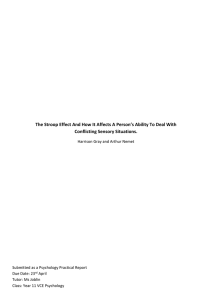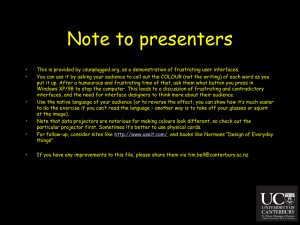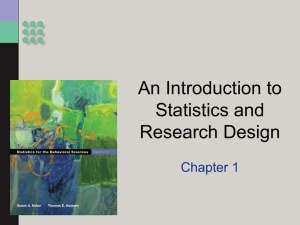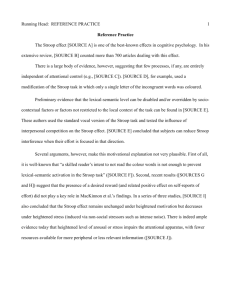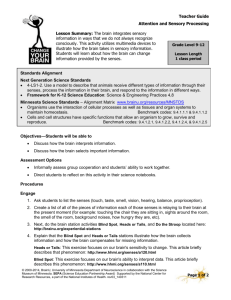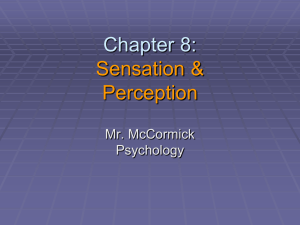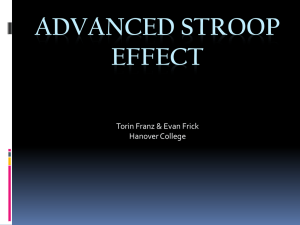Stroop Effect ERA
advertisement
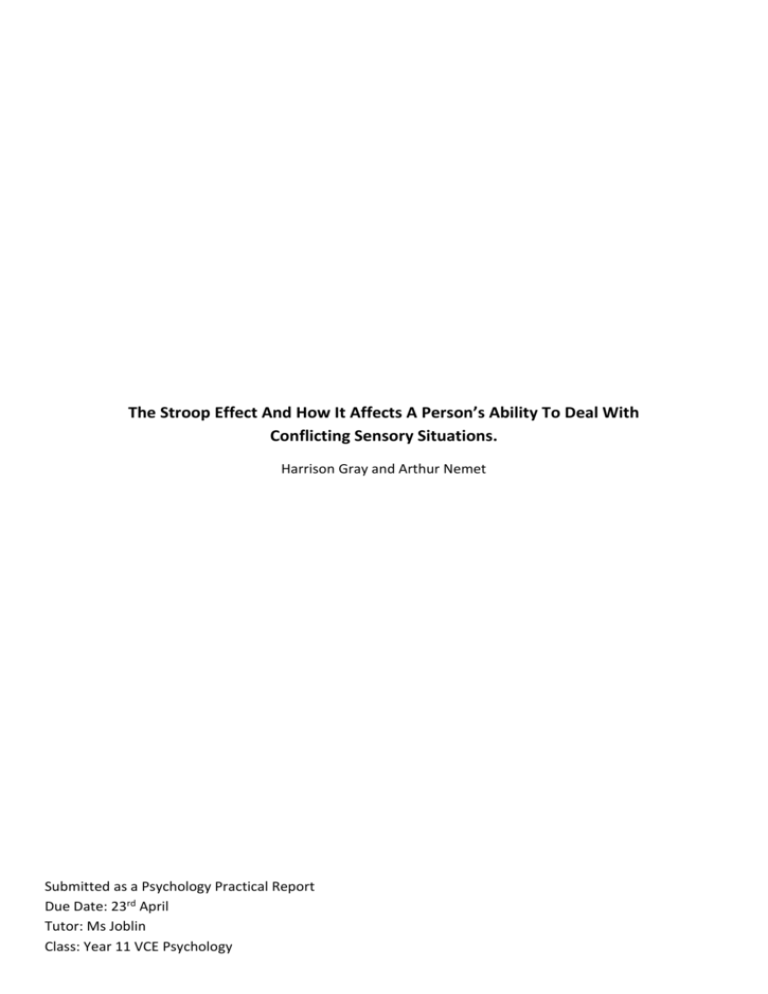
The Stroop Effect And How It Affects A Person’s Ability To Deal With Conflicting Sensory Situations. Harrison Gray and Arthur Nemet Submitted as a Psychology Practical Report Due Date: 23rd April Tutor: Ms Joblin Class: Year 11 VCE Psychology Abstract The experiment conducted in pairs by year 11 VCE Psychology students was aimed at replicating and confirming the results published in the Stroop effect and observing how they affect a person’s ability to deal with conflicting sensory information. By following the same principals of the original Stroop effect the Psychology students randomly chose people to test, in this way results could be clear and yet unclouded. The Hypothesis that The VCE students decided to use, was that the conflicting sensory data that people were given would indeed affect the time of there responses and impact on there ability to read the information out correctly and fluently. The VCE students also believed that out of all the conditions, condition one would be the most difficult for participants of the experiment to interpret due to it containing the most conflicting sensory information out of all the conditions. The Information collected by the VCE Psychology students after completing the experiment on the Stroop effect showed great similarities with the initial hypothesis suggesting that the Stroop effect is indeed an example of conflicting sensory information and its ability to confound and perplex the participant in certain ways. The secondary hypothesis was also proven to be correct as the majority of participants did suffer some problems associated with timing and errors. The results gathered by the VCE Psychology students show that the Stroop effect is an accurate representation of sensory perplexity. Since the dawn of time man has relied on his sense of perception to survive. There have been many ways over the years to which arise ways to confuse people with sensory information. One such way is known as the Stroop effect. The Stroop effect is the observation that individuals are more likely to make errors and will take a longer time to name the colour of the ink when the meaning of a word is different to that of the colour it is written in. The Stroop effect relies on different combinations of words and colours. The effect claims to cause the brain problems in efficiently processing competing inputs of sensory information and be able to cause people to make perceptual errors and take extra time in interpreting them. The independent variable in this experiment was the conditions given to the participants to read and interpret. The Dependant variable in this experiment is that of the results received by the VCE psychology students when completing there research; this will come in the form of time taken and number of errors made. The Hypothesis created by the VCE Psychology students performing the experiment to see if the Stroop effect was an observable way to view the difficulties the brain had in identifying conflicting sensory information, was that the conflicting sensory data that people were given would indeed affect the time of there responses and impact on there ability to read the information out correctly and fluently. The VCE Psychology students also decided that condition one would result in the least amount of errors and take the least amount of time and that condition two would include the most on both accounts because of the more conflicting sensory data. The research completed by American psychologist John Ridley Stroop has been repeated numerous times and has become a well known area of perception in psychology. Studies completed by people such as Macleod, Lindsey and Jacoby believe that the stroop effect occurs because when we are presented with a word, our autonomous response is to read the word. When we are confronted by competing information requiring our attention, our automatic response is to read the information. This intial response interferes with our attempt at naming the colour of the ink. Consequently, completing the latter component of colour identification requires greater attention and mental effort, which also take more time. These studies imply that Stroop’s effect could be a logical way to observe perceptual complexities arising in identifying information. 2 Method Participants The participants were all students of Lara Secondary College between the ages of 14 to 16, of both males and females. The participants were selected using random allocation. Materials Test sheet Stationary equipment Stopwatch Computer Procedure We established our aim and created our hypothesis on the results we would have at the conclusion of the study. We then transferred the test (Appendix 1) from our Psychology book to a sheet of folded paper. The way the paper was folded allowed us to show the participant each Condition (Appendix 1) without showing the other three until we wanted to. The data was written down in a book as the test occurred. We then graphed the data drew conclusions from it. Results Participants One Two Three Four Condition One Condition Two Condition Three Condition Four Time 4.84 4.58 3.57 5.58 Time 13.07 11.11 11.57 17.4 Time 6.56 5.81 9.43 5.6 Time 4.77 5.46 7.14 5.39 Errors 0 0 0 0 Errors 0 1 1 2 Errors 0 0 0 0 Errors 0 0 0 0 Measured in seconds and milliseconds 20 KEY 18 Condition One – Read the words 16 14 12 Participant One 10 Participant Two 8 Participant Three 6 Participant Four 4 Condition Two – State the colour of the ink Condition Three – State the colour of the block 2 0 Condition One Condition Two Condition Three Condition Four Condition Four – State the colour of the ink 3 Conditions One Two Three Four Tally (Errors) Total 0 3 0 0 III Discussion The data that was gathered has supported the hypothesis that the Stroop effect does indeed occur and the presence of competing sensory inputs causes the participants to become confused and make mistakes or slow down. The results also support the hypothesis that Condition One was the easiest, with all times under six seconds, and that Condition Two was the hardest, the only one with errors and lagging times. The contrast between the Condition One results and the Condition Two results show that by reading a colour in a different coloured ink causes the brain to take longer in determining the colour written, because it is confused with the colour it was printed in. In the participants haste, the brain isn’t fast enough to process the information and errors were made, although few. This research study has produced similar results to previous studies and through replication it has shown to have corresponding data. It can definitely be applied to the wider population that the Stroop effect does occur and that people find information harder to understand and interpret when confronted with conflicting sensory inputs. 4 References: Websites and internet based information on the Stroop Effect: http://psycnet.apa.org http://www.sciamdigital.com Books: Psychology for the VCE student 5th Edition Page 102 5 Appendices Appendix 1 Appendix 2
